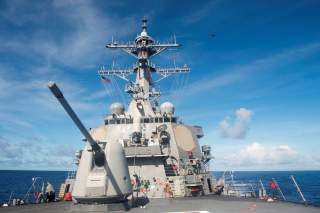The Navy Has a "Ghost Fleet" but How Do You Really Count Robot Warships?
An interesting problem.
Key Point: Obviously, a ship is a ship. But the Navy is having political problems on what qualifies as a "ship" for housekeeping purposes.
Congressional legislators rumbled with displeasure in December 2019 when the Office of Management and Budget released a memo proposing to early retire a dozen U.S. Navy ships in service and cut twelve more that are on order.
The vessels affected included operational Ticonderoga-class cruisers, littoral combat ships and San Antonio-class landing platform docks, as well as orders for new Arleigh Burke-class destroyers, CHAMPS auxiliary ships, a Virginia-class submarine and a forthcoming FFG(X) frigate.
When combined with additional orders of newer ships, the OMB proposal leaves the Navy with three fewer ships than it started with, despite a (likely impossible) mandate to boost ship totals from 290 to 355 ships.
A companion article details the types of ships being cut, and the still vaguely-conceived successors the Navy sees stepping in to take their place. This piece will look at the political strategy that may underly the OMB proposal, and a peculiar bureaucratic problem which may be undermining the Navy’s modernization strategy.
Part of the difficulty facing the Navy budget, as that it wants to procure ten 2,000-ton LUSV drone warships as well as two smaller MUSV drone vessels with anti-submarine payloads, at a total cost of $3 billion.
In theory, robotic surface combatants could be much cheaper to build and operate than manned warships, could be employed more aggressively in areas threatened by anti-access/area denial weapons, and would allow the Navy to spread out its firepower more broadly without forcing it to stick humans on vulnerable ships like the LCS.
Above all, LUSVs could reduce the overwhelming operational burden placed on Navy’s over-worked destroyers, cruisers, littoral combat ships, and planned-for frigates.
But the drone ships of its “Ghost Fleet” don’t officially count towards the total number of ships in service. That makes it seem like the Navy is shrinking more than is actually the case.
It’s also worth noting that some critics think the Navy is mistaken to commit itself so heavily to drone ships before they have been operationally tested. For example, maintaining unmanned vessels at sea could prove challenging without crew on hand to patch up breakdowns.
Thus in 2019, Congress pushed back against the Navy plans, requesting a slower roll-out to buy time for more operational testing. That has resulted in LUSV procurement being reduced to one instead of two ships per year.
Whether skepticism towards drone warships is justified or not, the Navy needs to change the way it counts ships if large drone ships are destined to play a major role in the mid-twenty-first-century fleet.
It’s worth noting that the Navy is also planning to deploy drone submarines to perform reconnaissance and eventually combat roles—both types designed for autonomous independent operations, and smaller large-diameter UUVs that would be launched from a manned submarine mothership.
“Cry for Help” Strategy?
The attempt to retire Truman earlier in 2019 may indicate a political strategy underlying the cuts proposed in the OMB memo. The Truman’s proposed retirement raised howls of outrage in Congress—leading to additional money begin appropriated not only to fund Truman’s mid-life overhaul, but for a block purchase of two new (and infamously troubled) Ford-class carriers.
Thus, some see the OMB’s proposed cuts as amounting to another fishing expedition (or more charitably, a “cry for help”) intended to shake down Congress for money lest ship-building programs popular with their constituents pay the price.
However, the Navy must contend with the reality that most analysts don’t expect the U.S. defense budget to increase significantly beyond current levels in the next few years. The sea warfare branch, therefore, has to place bets on how likely a conflict is to occur in the near term, how much of its current fleet it can pawn off prematurely, and how long it can afford to wait for next-generation vessels like the LSC, FFG(X) and SSN(X) to pick up the slack.
By process of elimination, we can also see which current ship-building programs are prioritized by the U.S. Navy: its Gerald Ford-class supercarriers, America-class light carrier/amphibious ships, and forthcoming Columbia-class ballistic missile submarines.
The Columbia-class remains such a priority because they perform the critical role of providing the United States with nigh-unkillable sea-based nuclear deterrence. Furthermore, they must Ohio-class ballistic missile submarines as they begin to age out.
The emphasis on carrier construction also reflects that the Navy still centers its warfighting capabilities around the huge ships laden with jet fighters. Indeed, a large chunk of the Navy’s frigates, destroyers, cruiser sand submarines are dedicated solely to protecting carriers from attack.
Thus the budgeteers proved willing to cut an order for five highly capable destroyers rather than reduce planned carrier construction by a single ship. However, the Navy’s dedication to huge and expensive carriers may be myopic in an era when land-based anti-ship weapons are beginning to out-range the aircraft based on carriers.
Balancing the operational needs of the present with the technological needs of the future is a difficult equation to solve. But a healthy initial step towards solving it would be to count armed 2,000-ton vessels as “ships”, even if they don’t have humans onboard.
Sébastien Roblin writes on the technical, historical and political aspects of international security and conflict for publications including the The National Interest, NBC News, Forbes.com and War is Boring. He holds a Master’s degree from Georgetown University and served with the Peace Corps in China. You can follow his articles on Twitter. This first appeared in 2019.
Image: Reuters

